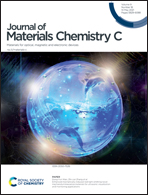Intrinsic auxeticity and negative piezoelectricity in two-dimensional group-IV dipnictide monolayers with in-plane anisotropy†
Abstract
Two-dimensional (2D) van der Waals (vdW) layered materials with orthorhombic symmetry and distinct planar crystallographic lattices down to the monolayer limit, can potentially display in-plane anisotropy and diverse functionalities arising from their structural anisotropy. Typically, group-IV monopnictides (SiP, SiAs, GeP and GeAs) and dipnictides (SiP2, SiAs2, GeP2 and GeAs2) are two prototypical types of synthetic vdW layered materials characterized by orthorhombic symmetry and in-plane anisotropy in their 2D layered structural forms. In the current work, in order to provide deep insights into the in-plane anisotropic properties and especially to explore the new functionalities associated with in-plane anisotropy that have not yet been uncovered experimentally so far, we perform first-principles calculations to systematically investigate the structural, mechanical, electronic and optical properties, and electromechanical responses for 2D group-IV monopnictide AB and dipnictide AB2 (A = Si and Ge, B = P and As) monolayers. Based on our calculations, both 2D monopnictide and dipnictide monolayers are predicted to exhibit in-plane anisotropy in their mechanical, electronic and optical absorption properties, including distinct elastic constants, Young's moduli, effective carrier masses and optical absorption along the two planar directions. Especially, owing to the unique 2D puckered crystal structure composed of corner-sharing AB4 tetrahedrons, AB2 monolayers can exhibit an extraordinarily large in-plane negative Poisson's ratio (NPR) of up to −0.32, making these group-IV dipnictides rare 2D auxetic materials. Moreover, compared to the centrosymmetric AB monopnictides, 2D AB2 monolayers are characterized by acentric symmetry, where non-zero electric polarization can be obtained along one of the planar axes. Such a structural polarity can lead to a sizable negative longitudinal piezoelectric coefficient d33 as large as −11.84 pC N−1. These intriguing properties arise from the in-plane anisotropy making 2D group-IV dipnictides of great promise for applications such as nanoscale auxetic sensors and low dimensional electromechanical devices.



 Please wait while we load your content...
Please wait while we load your content...